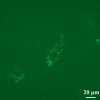Piezotolerance of the cytoskeletal structure in cultured deep-sea fish cells using DNA transfection and protein introduction techniques
- PMID: 19002837
- PMCID: PMC2151967
- DOI: 10.1007/s10616-007-9099-7
Piezotolerance of the cytoskeletal structure in cultured deep-sea fish cells using DNA transfection and protein introduction techniques
Abstract
We used DNA transfection and protein introduction techniques to investigate the pressure tolerance of cytoskeletal structures in pectoral fin cells derived from the deep-sea fish Simenchelys parasiticus (habitat depth, 366-2,630 m). The deep-sea fish cells have G418 resistance. The cell number increased until day 6 of cultivation and all cells had died by day 35 when cultured in 35-mm Petri dishes in medium containing G418. Enhanced yellow fluorescent protein-tagged human beta-actin (EYFP-actin) was stably expressed by 1 in 100,000 deep-sea fish cells. Because almost none of the EYFP-actin was incorporated into actin filaments of the cells, we replaced the relatively large EYFP tag with a chemical fluorescent compound and succeeded in incorporating fluorescently labeled rabbit actins into the deep-sea fish actin filaments. Most of the filament structure in the cells with rabbit actin inserted underwent depolymerization when subjected to pressure of 100 MPa for 20 min, in contrast to control cells. There were no differences in the tubulin filament structure between control cells and deep-sea fish cells with fluorescein-labeled bovine tubulin inserted after the application of pressure ranging from 40 to 100 MPa for 20 min.
Figures





Similar articles
-
Effects of the piezo-tolerance of cultured deep-sea eel cells on survival rates, cell proliferation, and cytoskeletal structures.Extremophiles. 2005 Dec;9(6):449-60. doi: 10.1007/s00792-005-0462-3. Epub 2005 Aug 5. Extremophiles. 2005. PMID: 16082498
-
Mechanism of deep-sea fish α-actin pressure tolerance investigated by molecular dynamics simulations.PLoS One. 2014 Jan 20;9(1):e85852. doi: 10.1371/journal.pone.0085852. eCollection 2014. PLoS One. 2014. PMID: 24465747 Free PMC article.
-
Cell biology of deep-sea multicellular organisms.Cytotechnology. 2007 Dec;55(2-3):125-33. doi: 10.1007/s10616-007-9110-3. Epub 2007 Nov 22. Cytotechnology. 2007. PMID: 19003002 Free PMC article.
-
Tissue culture of the deep-sea eel Simenchelys parasiticus collected at 1,162 m.Extremophiles. 2003 Jun;7(3):245-8. doi: 10.1007/s00792-003-0317-8. Epub 2003 Mar 28. Extremophiles. 2003. PMID: 12768456
-
Structural complexity of filaments formed from the actin and tubulin folds.Commun Integr Biol. 2016 Nov 23;9(6):e1242538. doi: 10.1080/19420889.2016.1242538. eCollection 2016. Commun Integr Biol. 2016. PMID: 28042378 Free PMC article. Review.
Cited by
-
Convergent Evolution and Structural Adaptation to the Deep Ocean in the Protein-Folding Chaperonin CCTα.Genome Biol Evol. 2020 Nov 3;12(11):1929-1942. doi: 10.1093/gbe/evaa167. Genome Biol Evol. 2020. PMID: 32780796 Free PMC article.
-
Electrical Retrieval of Living Microorganisms from Cryopreserved Marine Sponges Using a Potential-Controlled Electrode.Mar Biotechnol (NY). 2015 Oct;17(5):678-92. doi: 10.1007/s10126-015-9651-y. Epub 2015 Aug 5. Mar Biotechnol (NY). 2015. PMID: 26242755 Free PMC article.
References
-
- Alberts B, Johnson A, Lewis J, Raff M, Roberts K, Walter P (eds) (2002) Molecular biology of the cell, 4th edn. Garland Science, New York
-
- {'text': '', 'ref_index': 1, 'ids': [{'type': 'PubMed', 'value': '6193810', 'is_inner': True, 'url': 'https://pubmed.ncbi.nlm.nih.gov/6193810/'}]}
- Bar-Num S, Shneyour Y, Beckmann J (1983) G-418, an elongation inhibitor of 80S ribosomes. Biochim Biophys Acta 741:123–127 - PubMed
-
- {'text': '', 'ref_index': 1, 'ids': [{'type': 'DOI', 'value': '10.1002/cm.970100305', 'is_inner': False, 'url': 'https://doi.org/10.1002/cm.970100305'}, {'type': 'PubMed', 'value': '3052872', 'is_inner': True, 'url': 'https://pubmed.ncbi.nlm.nih.gov/3052872/'}]}
- Bourns B, Franklin S, Cassimeris L, Salmon ED (1988) High hydrostatic pressure effects in vivo: changes in cell morphology, microtubule assembly, and actin organization. Cell Motil Cytoskeleton 10:380–390 - PubMed
-
- {'text': '', 'ref_index': 1, 'ids': [{'type': 'DOI', 'value': '10.1006/excr.1996.0278', 'is_inner': False, 'url': 'https://doi.org/10.1006/excr.1996.0278'}, {'type': 'PubMed', 'value': '8831567', 'is_inner': True, 'url': 'https://pubmed.ncbi.nlm.nih.gov/8831567/'}]}
- Crenshaw HC, Allen JA, Skeen V, Harris A, Salmon ED (1996) Hydrostatic pressure has different effects on the assembly of tubulin, actin, myosin II, vinculin, talin, vimentin, and cytokeratin in mammalian tissue cells. Exp Cell Res 227:285–297 - PubMed
-
- {'text': '', 'ref_index': 1, 'ids': [{'type': 'PubMed', 'value': '7001938', 'is_inner': True, 'url': 'https://pubmed.ncbi.nlm.nih.gov/7001938/'}]}
- Davies J, Jimenez A (1980) A new selective agent for eukaryotic cloning vectors. Am J Trop Med Hyg 29:1089–1092 - PubMed
LinkOut - more resources
Full Text Sources

